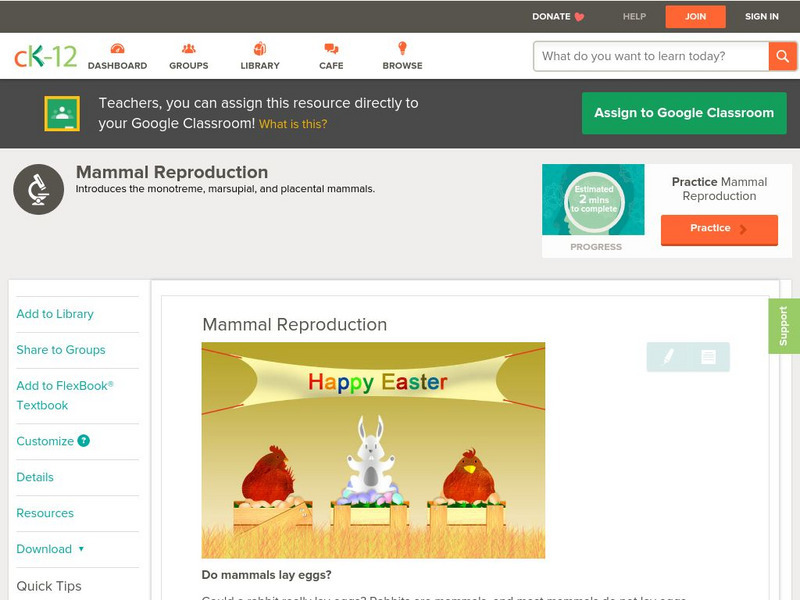Curated OER
Australian Mammals: Evolutionary Development as a Result of Geographic Isolation
Students comprehend the difference between monotremes, marsupials, and placental mammals. They are able to compare and contrast these organisms (Australian mammals) with other mammals. Students are able to identify Australian mammals.
Curated OER
Diversity of Mammals
In this mammals instructional activity, high schoolers compare and contrast the three types of mammals: placental, marsupial, and monotreme. This instructional activity has 4 short answer, 12 matching, and 8 fill in the blank questions.
Curated OER
The Diversity of Mammals
In this mammals activity, students use idea maps about monotremes, marsupials, and placental mammals to complete 3 short answer questions.
Curated OER
Australian Mammals: Evolultionary Development as a Result of Geographic Isolation
Students examine the differences between monotremes, marsupials, and placental mammals and are able to contrast these organisms with other mammals. They learn about unique variation and the diversity of mammals located in Australia.
Curated OER
Mammals
In this mammals worksheet, high schoolers review terms associated with the different types of mammals. This worksheet has 6 fill in the blank and 4 matching questions.
Curated OER
Australia
Students identify animals that are unique to Australia, study their habitation and how they fit in their environment. In this exploratory lesson students research a topic to find out specific information about it.
Curated OER
Birds and Mammals
Providing a higher-level thinking experience, this presentation provides an in-depth and interesting review of mammals. The terms used in the presentation give students a chance to be exposed to scientific classifications. There is also...
Curated OER
Environment: Endangered Mammal Project
Students research different mammals and create illustrations and narratives about them. Working individually or in small groups, students compose their rough drafts prior to creating their posters or dioramas. Students present short...
Biology Junction
Mammals
Mammals include more than 4,000 species and represent the most dominant land animals on Earth. Scholars learn about the large variety of mammals, including orders unfamiliar to most. The presentation highlights the characteristics and...
McGraw Hill
Chapter 21: Mammals
Although the instructional activity found here is designed to accompany a particular textbook reading, it is a good basic review or study guide when learning about mammals. If you have a text that covers these concepts, young scientists...
Curated OER
Mammals of Fields, Meadows, and Hedgerows
In this mammals worksheet, students research the internet to find information and answer short answer questions about mammals of fields, meadows, and hedgerows. Students complete 12 questions.
Curated OER
Vertebrates
Students identify and describe five main groups of the Phylum Chordata. They discover that the Phylum Chordata is the vertebrates. Students identify the main difference between invertebrates and vertebrates. They read passages about...
Curated OER
Marvelous Mammals- Non-Fiction Reading Comprehension Worksheets
In this mammals non-fiction reading comprehension worksheet, 3rd graders read a one page selection about the characteristics of mammals. They answer 10 questions based on the reading including true and false, short answer, and multiple...
Curated OER
Connect the Dots
In this connect the dot worksheet, students connect the dots to reveal the two kinds of mammals that lay leathery eggs instead of giving birth to live young.
Curated OER
Vertebrate Classification Challenge
Students determine which animals belong to the vertebrate phyla. In this classification lesson, students are given large papers with the names of the phyla of vertebrates. They must work together to place organisms into their...
Curated OER
Mammals Crossword
In this mammals activity, students complete a crossword puzzle with 37 questions about characteristics, behavior and types of mammals.
Curated OER
An "Eggs"traordinary Sculpture
Eighth graders identify and categorize different types of animals which lay eggs, use a five step method for viewing and interpreting a piece of artwork, and use an indirect method to find the mass of a large object.
Regents of the University of Michigan
Animal Diversity Web: Order Monotremata (Monotremes)
Animal Diversity Web offers a comprehensive look at monotremes. In addition to a general overview of monotremes, content includes numerous photographs and specimens, and a look at their classification.
CK-12 Foundation
Ck 12: Biology: Monotremes
[Free Registration/Login may be required to access all resource tools.] Describes how monotremes reproduce.
University of California
Ucmp: Monotremes, Egg Laying Mammals
University of California Berkeley offers a short, concise description about egg-laying mammals with links to more in-depth information.
CK-12 Foundation
Ck 12: Life Science: Mammal Reproduction
[Free Registration/Login may be required to access all resource tools.] Mammals don't typically lay eggs, but monotremes are the exception. All other mammals give birth to live young and belong to one of two categories, the marsupials...
TED Talks
Ted: Ted Ed: The Three Different Ways Mammals Give Birth
Kate Slabosky details the placental, marsupial, and monotreme methods of giving birth.
CK-12 Foundation
Ck 12: Biology: Evolution of Early Mammals
[Free Registration/Login may be required to access all resource tools.] Overview of the evolution of monotreme, marsupial, and placental mammals.
San Diego Zoo Global
San Diego Zoo: Mammals
This resource provides extensive information about mammals.























